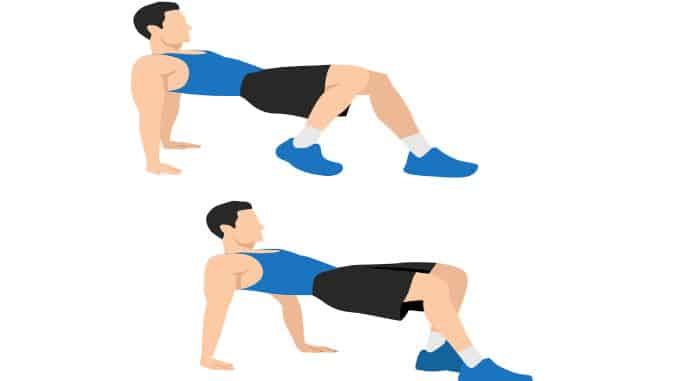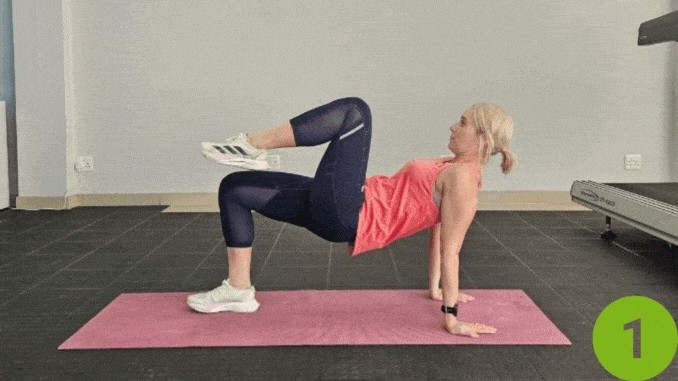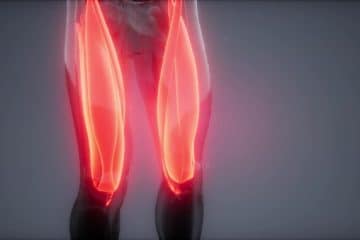Embark on a fitness journey that combines fun and function with the Crab Walk exercise! This engaging and effective workout is designed to strengthen your core while involving your arms and legs in a full-body challenge.
The Crab Walk is a versatile option requiring no equipment, whether at home, in a park, or anywhere with a bit of space.
Suitable for individuals aiming to boost fitness without gym equipment, this exercise strengthens core muscles and enhances stability, mobility, and coordination.
Dive into the Crab Walk and transform your core strength into your power center, making every move a step towards a stronger, more balanced you.
What is the Crab Walk Exercise?

The crab walk is a bodyweight exercise that mimics the movement of a crab. Targeting several muscle groups involves the abdominals, glutes, shoulders, and triceps.
To perform this exercise, sit on the ground with your hands on the floor and fingers pointing towards your feet. Raise your hips off the ground and proceed forward by walking on your hands and feet, ensuring your core is activated and your body remains parallel to the floor.
Incorporating crab walks into your routine offers a great way to strengthen your core and enhance overall body strength.
Since this exercise requires no equipment and can be executed anywhere, it's convenient for individuals with limited gym access or who prefer home-based workouts. It is also a functional movement, miming daily movements, such as crawling or climbing stairs.
Crab Walk Exercise Benefits

The crab walk exercise offers a range of benefits for your physical and mental well-being. Here are some of the key benefits of incorporating the crab walk exercise into your workout routine:
- Strengthening the Core: Core muscles, including the abs and obliques, are the primary targets of the crab walk exercise. Strengthening these muscles improves core stability, which is vital for sustaining proper posture and avoiding back discomfort.
- Improving Upper Body Strength: Crab walking also engages your arms, shoulders, and chest muscles. Walking on your hands, you'll strengthen these muscle groups, giving you a stronger upper body and stability.
- Enhancing Lower Body Strength: In addition to targeting the core and upper body, the crab walk exercise engages muscles in the lower body, including the glutes, quadriceps, and hamstrings. Improving lower body strength and stability can make walking, running, and climbing stairs easier.
- Boosting Coordination and Balance: The crab walk exercise requires coordination and balance as you simultaneously move your upper and lower body. Regular practice can improve your body awareness, coordination, and balance, positively impacting your physical performance.
- Increasing Flexibility: The crab walk exercise involves stretching and opening up the hips and shoulder blades, which can help improve flexibility in these areas. Enhanced flexibility can widen your range of motion and lower the likelihood of injury during various exercises or activities.
- Adding Variety to Your Workout Routine: Incorporating the crab walk exercise into your routine can add variety and challenge to your workouts. This exercise offers a fun and distinct approach to staying motivated and involved in your fitness quest.
Muscles targeted by the Crab Walk Exercise

The crab walk exercise targets several major muscle groups in the body. Here are the primary muscles that are engaged during the crab walk exercise:
- Abdominals: The crab walk exercise is an excellent way to focus on the abdominal muscles, including the rectus abdominis (six-pack muscles) and obliques. These muscles are crucial in maintaining core stability, supporting the spine, and improving posture.
- Glutes: The gluteal muscles gluteus maximus, medius, and minimus, are engaged during the crab walk exercise. These muscles are responsible for hip extension and significantly affect lower body strength and stability.
- Quadriceps: The quadriceps muscles [1], located at the upper legs, are also targeted during the crab walk exercise. These muscles are responsible for knee extension and hip flexion and are crucial in walking, running, and other lower-body movements.
- Hamstrings: The hamstrings,[2] located at the back of the thighs, are engaged during the crab walk exercise. These muscles assist in hip extension and knee flexion and are important for lower body strength and stability.
- Shoulders: The crab walk exercise engages the muscles in the shoulders, including the deltoids and rotator cuff muscles. These muscles help stabilize the shoulder joint and assist in the movement of the arms during the exercise.
- Triceps: The triceps at the back of the upper arm are also targeted during the crab walk exercise. These muscles assist in elbow extension and play an important role in upper body strength and stability.
By targeting these major muscle groups, the crab walk exercise provides a comprehensive full-body exercise that can help improve strength, stability, and overall physical performance.
How to Crab Walk Exercise?
Proper crab walk form and techniques are important to perform the exercise correctly.
Begin in an upright sitting position, your knees bent, and feet flat on the floor. Rest your hands on the floor behind you. Make sure your fingers are pointing toward your feet. Engage your core and lift your hips, pushing through your hands and feet. Start walking forward by moving your opposite hand and foot simultaneously. For example, if you move your left hand forward, your right foot should move forward at the same time. Continue walking this way, keeping your core engaged and your body parallel to the floor. As you walk, focus on maintaining proper form. Keep your hips lifted, core engaged, chin tucked lightly, and shoulders stable. Avoid letting your hips sag, or your shoulders hunch. After completing the desired distance or time, rest briefly before repeating the exercise for the desired number of sets.
Crab Walk Variations
The crab walk exercise can be modified to accommodate different fitness levels and goals. Here are some variations of the crab walk exercise that you can try:
1. Crab Walk with Leg Lift
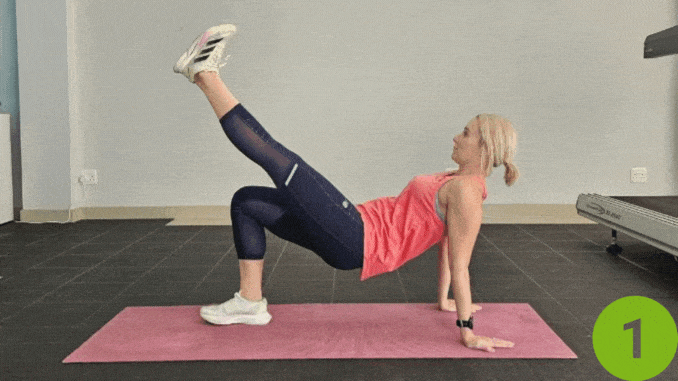
- Begin in an upright sitting position on the floor, with your knees bent, and feet flat on the floor. Press your hands on the floor behind you.
- Ensure your fingers point forward in the same direction as your head.
- Engage your core and lift your hips, pushing through your hands and feet.
- Walk forward by moving your opposite hand and foot simultaneously. If you move your Right hand forward, your left foot should move forward simultaneously.
- After a few steps, pause to lift one leg straight toward the ceiling while raising your hips, then lower the leg and continue walking.
- Alternate leg lifts every few steps. After completing the desired distance or time, rest briefly before repeating the exercise for the desired number of sets.
2. Crab Walk with Knee Tuck
- Begin in an upright sitting position on the floor, your knees bent and feet flat on the floor.
- Press your hands on the floor behind you.
- Ensure your fingers point forward in the same direction as your head.
- Engage your core and lift your hips, pushing through your hands and feet.
- Walk forward by moving your opposite hand and foot simultaneously.
- After a few steps, pause and bring one knee toward your chest while lifting your hips. Lower the leg back down and continue crab walking.
- Alternate knee tucks every few steps; after completing the desired distance or time, rest briefly before repeating the exercise for the desired number of sets.
3. Crab Walk with Resistance Band
For this exercise, you may utilize a mini band.
- Begin in an upright standing position with your feet shoulder-width apart, maintaining a good alignment with your head, shoulder, hips, and legs.
- Place a mini band around your thighs, just above your knees.
- Grasp your hand at chest height, engage your core, and squat slightly into an athletic stance.
- Begin moving sideways in a crab walk motion, taking small steps to the side.
- After completing the desired distance or time, rest briefly before repeating the exercise for the desired number of sets.
4. Crab Walk with Toe Touch
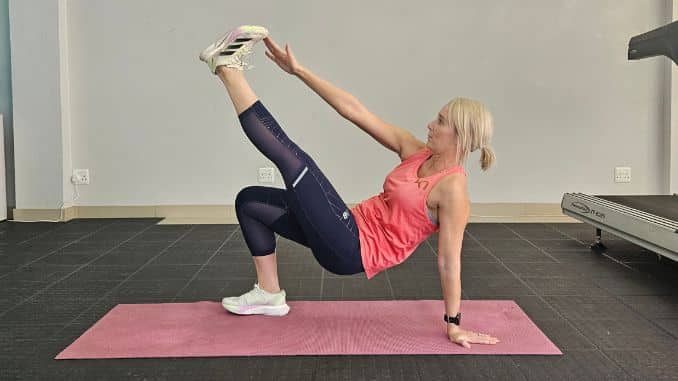
- Begin in an upright sitting position on the floor, your knees bent and feet flat on the floor.
- Press your hands on the floor behind you. Ensure your fingers point forward in the same direction as your head.
- Engage your core and lift your hips, pushing through your hands and feet.
- Walk forward by moving your opposite hand and foot simultaneously. After a few steps, pause and lift one leg upward and reach the toes with your opposite hand.
- Return to the starting position and continue crab walking. Alternate toe touch every few steps.
- After completing the desired distance or time, rest briefly before repeating the exercise for the desired number of sets.
5. Crab Walk with Dumbbells
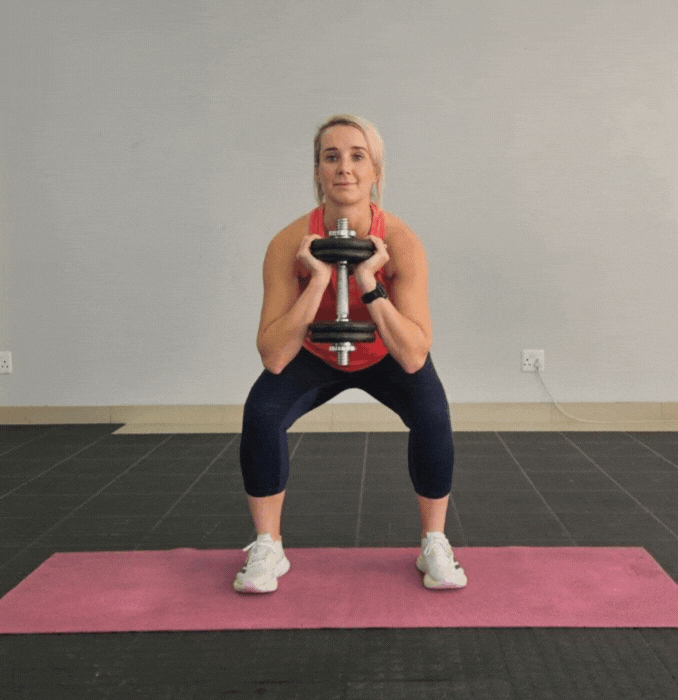
For this exercise, you may utilize a dumbbell, a big can of soup, or a big soda bottle.
- Begin in an upright standing position with your feet shoulder-width apart, maintaining good alignment with your head, shoulders, hips, and legs.
- Hold the top end of the dumbbell with both hands in front of your body at chest- height. Engage your core.
- Bend your knees and hinge through your hips to move into a squat position, keeping your knees behind your toes.
- Begin moving sideways in a crab walk motion, taking small steps to the side.
- After completing the desired distance or time, rest briefly before repeating the exercise for the desired number of sets.
Experiment with these variations to find the ones that challenge you the most and align with your fitness goals. Remember always to prioritize proper form and technique to prevent injury and maximize the effectiveness of the exercise.
Incorporating the Crab Walk Exercise into your workout routine
The crab walk exercise can be incorporated into your workout routine or used as a standalone exercise. Here are some tips for incorporating the crab walk exercise into your workout routine:
- Warm-up: Before exercising, warm up muscles with light cardio and dynamic stretches to boost mobility and flexibility.
- Choose a designated area: Pick a clear, hazard-free space for crab walks, ensuring enough room to move comfortably.
- Determine duration or distance: Gradually increase the intensity of crab walks by setting a challenging yet manageable duration or distance.
- Combine with other exercises: Mix crab walks with bodyweight squats or push-ups for a comprehensive workout.
- Rest and recovery: Allow for rest days between crab walk sessions to prevent overtraining and promote muscle recovery.
- Track progress: Record crab walk workouts to monitor improvements in duration, distance, or repetitions over time.
Remember to listen to your body and modify the exercise as needed. If you experience pain or discomfort, stop the exercise and consult a fitness professional.
Common mistakes to avoid while performing the Crab Walk Exercise
To get the most out of the crab walk exercise and prevent injury, it's essential to avoid these common mistakes:
- Sagging or arching the lower back: Maintain a neutral spine throughout the exercise and avoid sagging or arching your lower back. This can put unnecessary strain on the spine and increase the risk of injury.
- Rushing the movement: Take your time and focus on maintaining control and proper form during the crab walk exercise. Avoid rushing or using momentum to propel yourself forward.
- Losing core engagement: Keep your core muscles engaged throughout the exercise. This helps stabilize your body and allows you to maintain proper alignment and form.
- Neglecting proper hand and foot placement: Ensure that your hands are placed directly beneath your shoulders and your feet are hip-width apart. This provides a stable support base and allows for proper alignment during the exercise.
- Not breathing properly: Remember to breathe throughout the exercise. Inhale as you prepare to move, and exhale as you perform each step. Proper breathing helps provide oxygen to the muscles and promotes relaxation.
By avoiding these common mistakes and focusing on proper form and technique, you can maximize the effectiveness of the crab walk exercise and reduce the risk of injury.
Safety precautions and considerations for the Crab Walk Exercise

While the crab walk exercise is generally safe for most individuals, it's essential to consider the following safety precautions:
- Consult with a fitness professional: If you're new to exercise or have pre-existing medical conditions or injuries, it's advisable to consult with a fitness professional before attempting the crab walk exercise. They can assess your fitness level and guide proper form and technique.
- Start slowly and progress gradually: Begin with a duration or distance that feels challenging but manageable, and gradually increase the intensity over time. This allows your body to adapt to the exercise and reduces the risk of injury.
- Listen to your body. Feel how your body feels during the exercise. Stop and consult a healthcare professional if you experience pain, discomfort, or dizziness.
- Use proper padding: If you're performing the crab walk exercise on a hard surface, consider using a yoga mat or other cushioning to support and reduce pressure on your hands and feet.
- Stay hydrated: Drink more water before, during, and after your crab walk workout to prevent dehydration.
- Modify as needed: If you have any limitations or injuries that prevent you from performing the crab walk exercise as described, modify the exercise to suit your needs. For example, you can perform a seated crab walk or use a resistance band for assistance.
Always prioritize your safety and well-being when performing any exercise. If you're unsure about your ability to perform the crab walk exercise safely, consult with a healthcare professional or fitness expert.
Tips for Maximizing the Effectiveness of the Crab Walk Exercise
To get the most out of your crab walk exercise and maximize its effectiveness, consider incorporating these tips into your routine:
- Progress gradually: If you're new to the crab walk exercise, start with shorter distances or time intervals and gradually increase as you build strength and confidence. This will help prevent overexertion and reduce the risk of injuries.
- Combine with other exercises: The crab walk can be a great inclusion to a full-body workout routine. Consider combining it with other exercises that target different muscle groups to create a well-rounded and challenging workout. For example, you can incorporate push-ups, lunges, or planks into your routine.
- Add resistance: To further challenge your muscles and increase the intensity of the crab walk, consider adding resistance. You can do this by placing a weight plate or dumbbell on your hips or wearing a weighted vest. This will engage your muscles even more and help you see faster progress.
- Incorporate variations: While the basic crab walk is highly effective, there are also variations that you can incorporate to add variety and target different muscle groups. For example, you can try the crab walk with a leg lift, raising one leg off the ground with each step. This variation increases the engagement of your glutes and hamstrings.
- Stay consistent: Like any exercise, consistency is key to seeing results. Aim to incorporate the crab walk exercise into your routine at least two to three times per week. Consistently challenging your muscles will help you build strength and endurance over time.
Remember to listen to your body and adjust the intensity and frequency of the crab walk exercise to fit your fitness level and goals. If you feel any pain or discomfort at the onset or after the exercise, stop and consult with a healthcare professional or fitness expert.
Conclusion and final thoughts on the Crab Walk Exercise
The crab walk exercise is a fun and powerful way to strengthen your core, engage your arms and legs, and improve overall body strength. Whether you're looking to switch up your workout routine, add variety, or challenge yourself, the crab walk is an adaptable exercise that can be done anywhere.
To get the most out of this dynamic exercise, focus on proper form and technique, avoid common mistakes, and incorporate tips to maximize effectiveness. Remember to start gradually, progress at your own pace, and listen to your body.
So, try the crab walk exercise next time you want a challenging and engaging workout. This fun and effective exercise will strengthen your core, improve your stability and mobility, and take your fitness to the next level.
Ready to transform your fitness journey? Dive into the Crab Walk exercise today for a fun, full-body challenge! Don't forget to check out our 10 Easy Movements For A Stronger Core for more ways to build rock-solid abs.

